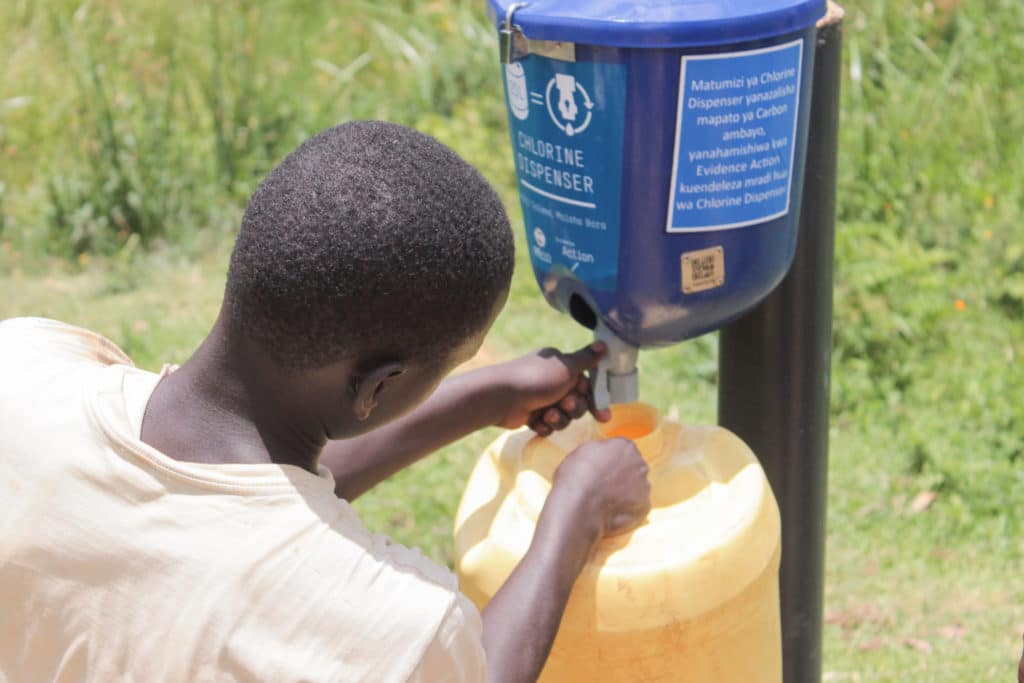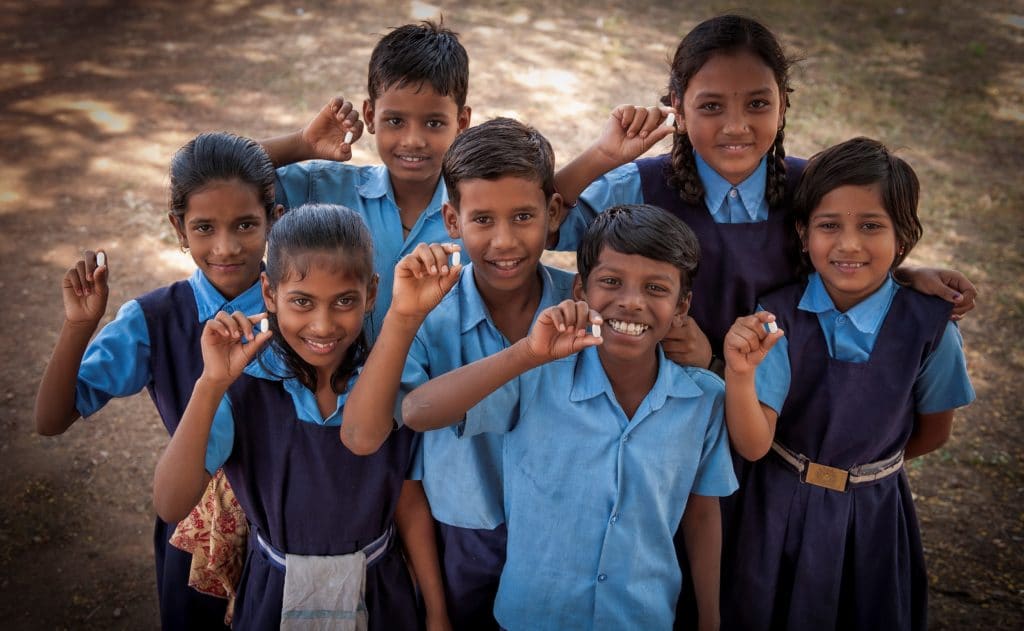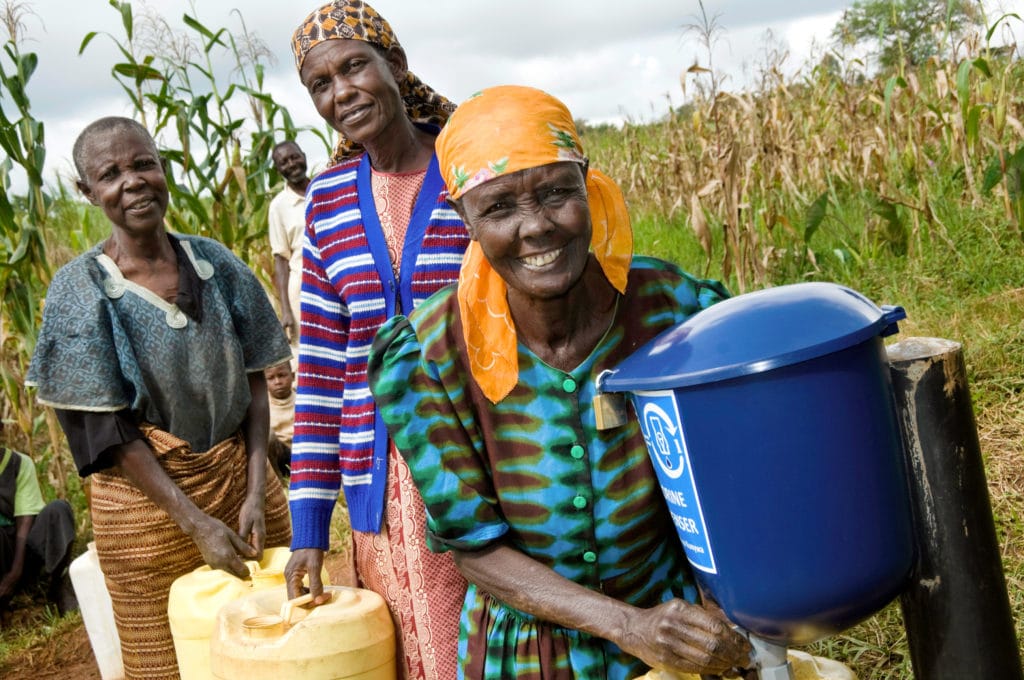Evidence Action Interview
Parasitic worm infection in young children poses a great threat to 868 million at risk youth around the world.
Evidence Action annually treats 280 million children across India, Pakistan, Kenya, Nigeria and Ethiopia.
With a simple tablet, student attendance could increase by 25% at a cost of $0.50 per child per year.
Listen here or find us on your favorite podcast app.
November 15, 2020
Evidence Action: Deworming the World



Evidence Action Deworming the World
We recently spoke with Grace Hollister from Evidence Action about how parasitic worm infection in young children poses a great threat to 868 million at risk youth around the world. As chief engagement officer and global deworming lead, Grace introduced their Deworm the World project, which works with government agencies and schools to combat intestinal parasites in young students. With a simple tablet, student attendance could increase by 25%. Check out the video interview here.
As an NGO, Evidence Action is funded entirely on donations. Their mission began its expansion after their flagship Dispensers for Safe Water project, which was underpinned for a Nobel Peace Prize in 2019. The project’s intention was to reduce the prominence of diarrhea in communities suffering from clean water insecurity. They administered small doses of chlorine to local water sources, which drastically reduced the risk of contamination and re-contamination of harmful bacteria. This intervention subsequently proved to reduce the rate of child mortality in impacted communities.
Treating 280 Million Children Every Year
Evidence action also leads the largest school-based deworming project, treating 280 million children every year across India, Pakistan, Kenya, Nigeria and Ethiopia. Instead of providing medicine directly to schools, partnerships are formed with local governments who leverage their current infrastructure for distribution. Intestational infection by parasites induces broad feelings of sickness and exhaustion without any distinct symptoms and can have long lasting effects. With symptoms like these, young students are likely to take time off school. Because of this, teachers are the ones who administer medication at an average of $0.50 per child per year. This model promotes a sustainable, cost-effective approach to global health while guiding communities closer to autonomy.
In addition to deworming, Evidence Action is fully devoted to the overall betterment of health through sustainable development. Iron deficiency contributes to nearly 50% of anemia cases worldwide, which affects more than 3.5 million people. In 2018, a campaign created to combat anemia by the government of India struggled to properly disseminate medicine and information about their cause. In 2019, Evidence Action offered technical assistance to the government of India to fortify their national health policies. They suggested that iron and folic acid supplementation be administered alongside deworming medication and today, they support delivery and coverage of the program. Healthy partnerships with local government has allowed the organization to broaden their reach in order to meet the challenges of today.
Want to learn more about Evidence Action? You can subscribe to their newsletter, checkout their blog and follow them on Facebook, Instagram and Twitter.
Great.com is an innovative charity project working to move money from the online casinos towards initiatives focused on preventing climate change. So far, Great.com has generated donations of over $1.3 million. This is done by competing with casinos in Google search rankings for online gaming signups coming from search terms such as "Tropicana Online Casino" and "online casino bonus". The profits this generates are then donated to causes working to stop global warming, rather than being reinvested into the casino industry.
[00:00:00]
Every day you and I get bombarded with negative news. And just like our bodies, become what we eat, our minds become the information that we consume. If you want to stay positive, it’s so important that you also listen to stories that inspire you and uplift you. In this podcast we interview leading experts dedicated to solving the world’s most pressing problems. And if you stick around, I promise you will not only be as informed as if you watched the news, you will be uplifted, inspired, and have more positive energy in your life. Welcome to Great.com Talks With.
[00:00:44]
Hi and welcome. Today, Great.com speaks with Grace Hollister from EvidenceAction.org. And today we’re going to speak about one of the most cost effective ways there is to help humans on this planet. But before I tell you what it is, make sure you click like and subscribe if you’re new to this channel so you can keep up to date with positive and inspiring news. And one of the most cost effective ways to help humans on this planet is deworming. A staggering one hundred and sixty eight million children are at risk of parasitic worm infections. And I’ll let you take it from here. Grace, welcome to Great Talks With.
[00:01:28]
Really nice to be here. Thank you so much for having me Emil.
[00:01:30]
So let me be a bit more specific. How would you describe the problem of parasitic worm infections and explain why it is so cost effective to someone that might not be familiar with this problem?
[00:01:43]
Yes, well, so parasitic worms are one of those things that for many of us that live in the developed world are not part of everyday lives, but they are very much a part of everyday life for many children in developing countries around the world. And mainly that’s because poor sanitation conditions often lead to infection with parasitic worms. And once those worms are inside you, they effectively sort of suck the energy that you would otherwise be using to do things like go to school, learn, be productive in your everyday life. And they are effectively feeding on you and taking some of that away. And so this is a problem that, as you said, affects so many children around the world and really so many people around the world. Do you want the world and the work that we do is around what we call school-based deworming, and so really the concept is quite simple. There are effective drugs that are very safe and they’re simple to administer. And those drugs have been around for many years and are used routinely in health care systems throughout the world. The challenge really for the children, the programs that we support is that those drugs are not necessarily available to families and to children where they need them and when they need them. And that’s often because people who are infected with worms don’t actually know that that’s what’s wrong with them. They might feel sick, they might feel tired. But if there aren’t really easily identifiable symptoms. And so people might not even think that it’s worth going to the health clinic nearby to get their children looked at or to try and understand what’s wrong with them. So what we do, instead of that sort of model where you where people would need to seek treatment, is we ensure that treatment seeks them. And so children go to school as part of their everyday activities and teachers are trained to be able to deliver medication to the students where they are.
[00:04:03]
Oh, that’s so smart. So what kind of results then are you seeing? Is there a way to test the difference between a school that gets access to these kinds of medicines compared to those who don’t?
[00:04:17]
So there have been actually some of the most rigorous randomized control trials, which is what those of us in the space referred to often as the gold standard for evidence about what works in development. And so what the
authors of those studies have found one of them is Michael Kramer, who was one of the three winners of the Nobel Prize in economics sciences last year. He and his colleague Ted Miguel, back in the early 2000s were actually looking at exactly that question. What happens if we deworm kids in some schools and then in other nearby schools we don’t provide treatment. Is there a difference? And what they found was actually quite astonishing and really is the foundation for the work that we do and the foundation for not just the work of our organization, but many organizations who also work on school based deworming. And what they found is that children who were treated for worms, that absentee rates in those schools actually dropped by twenty five percent. So many, many more children were in school as a result of being treated for worms.
[00:05:33]
And so it’s been really seen as not only a really cost effective intervention and I can get to the cost effectiveness part in a second, but not only for health outcomes, but also for education outcomes as well.
[00:05:47]
My previous question was a bit misleading because the story about Michael Kramer was my biggest aha moment when I started as someone who had no idea about anything when it comes to charity, started to read up on how to do charity efficiently because I wanted to somehow help children get better education. That was kind of my passion when I got into this. And my first idea was to help out and build a school in Africa. My friends were doing a project and then I read about this, that you can improve the attendance rates with 25 percent with this super cheap pill. I think back then it was one dollar for one child. I don’t know if that is still correct, but it was such an aha moment that I would never have thought of deworming as a solution to allow kids to be more in school. And it really showed me the importance of doing your research and not just following your heart is good as well, but you shouldn’t leave your mind behind.
[00:06:48]
Exactly. And I think that evidence action, which is our parent organization for Deworm the World, does exactly that, is trying to figure out what are those mechanisms that really are proven to work. Where is their research like the research you were referring to that shows what interventions we might be looking at that have potentially been overlooked, in part because that instinct that you and others and certainly I have about what works isn’t necessarily always borne out by the data.
[00:07:24]
And so I think that that’s part of why deworming is it has been not only a success, but also sort of the poster child, if you will, for a lot of this movement toward how we not only develop evidence, but also then how we use evidence to help make decisions and to help governments make decisions about what to scale up. Truly, the success of Deworm the World is not solely because of our organization. We exist to support governments. And so all of the work we do in the world does is in partnership with governments using their systems. To your point and your question about cost effectiveness, that actually is what makes deworming cost effective Evidence Action is not an organization that has decided to go into every school in a country like Kenya or a country like India. There’s no way that we could do that. What we do is we help the government figure out how to leverage their existing infrastructure. And as I said before, teachers, they’re the ones who deliver the medication. So that is in part what makes it so incredibly cheap to do. What we typically say these days is that deworming costs less than fifty cents per child per treatment. And so I think the costs have certainly come down from those early research studies, which makes a lot of sense, given that we’re working at a much bigger scale than that original research was was looking at.
[00:08:56]
Right.
[00:08:58]
Yeah, it’s such an amazing opportunity and also you then give the children more resilience towards other diseases like malaria and. But two questions get raised when I hear this.
[00:09:11]
We have this amazing, cost effective way of helping people. And then I have that in contrast with the data I mentioned at the beginning, that eight hundred and sixty eight million children are still at risk for these diseases. So first, I wonder, are we making progress? How is the progress looking and why do we still have this problem if the solution is so cheap? Like what needs to change to eradicate these diseases or lower them?
[00:09:41]
Yes, well, certainly all really good questions. So the first thing is just to point out that the eight hundred and sixty eight million children are at risk includes all of those areas where treatment is ongoing. And that’s because in those places, those children are at risk. So they’re being regularly treated, unfortunately, with intestinal worms. You can’t
just treat a child once or maybe twice and then walk away. It is actually something that needs to happen, usually about once a year for a sustained period of time to actually bring those infection rates down so that children are being reinfected with worms after they’ve been treated. And so that’s part of our premise of partnering with governments is governments continue to be there are able to to continue to deliver these programs with
support. And hopefully one day some of them might be able to do it without support from organizations like ours. There’s been a tremendous amount of progress, certainly since I’ve been working in this space, which started in 2011, and the what we would call a scale up of deworming globally has really been quite tremendous in that time.
[00:11:03]
A lot of the countries with the highest burden, so those with the largest numbers of at risk children are now treating many children, maybe not all of the ones who need to be treated, but are treating quite substantial numbers of them. And we’ve been incredibly proud to have been part of those programs, the largest school based deworming program in the world, which is the one in India, the government of India is now treating up until covid hit around two hundred and seventy million children each year for intestinal worms, which is just mind boggling when thinking about the all of the effort that goes into that program. But countries like Nigeria have been scaling up their programs recently. We’re now working in Pakistan, which was one of the countries that was sort of more neglected and a little bit behind in terms of still having children at risk who aren’t being treated. And so we’re working there now and partnering with the government. So there is still a way to go. I won’t say that the problem has been solved.
[00:12:08]
And we do.
[00:12:11]
Part of the challenge, I think, with some of those children who still aren’t being reached is some of those countries that are actually much more difficult to work in and places where actually children might not be in school. And so when you don’t have high enough numbers of children in school or school based programs aren’t necessarily going to be the solution. And so there are certain countries which will need different types of solutions for their worm infection.
[00:12:39]
Right.
[00:12:40]
And I can see the challenges with all these different areas and governments, so it makes a lot of sense to work with the governments to solve this problem. So for your organization, then, evidence action, what would be where you would like to be in five years? But it would be a great success for you.
[00:12:57]
Well, one of the things that we are looking at, certainly specifically on the deworming side, I’ll start with that, is that we are able to reach additional children who might be at risk and who should be getting treated at school, because that’s what makes the most sense, both from a feasibility standpoint, actually being able to deliver the treatment to them, but also certainly from a cost effectiveness standpoint. And so we’re continuing to look at are there other countries where our help and support might be needed? As I mentioned before, one of the other things that we’re looking at is can countries be working on these programs and implementing these programs without external support? And so we are looking to potentially exit some countries that we’ve been working in, but with the understanding that we would still be there just to provide support if and when that was needed. Again, such that countries can really bring this problem under control. I think more broadly for forever. The president’s action, certainly. There are other solutions out there that are not skill-based deworming, but, for instance, other school based programs. One of the things that we’re working on now, building on the work that we’ve done in learning is what’s called iron and folic acid supplementation.
[00:14:24]
And that is, again, another treatment that’s delivered that can be delivered through schools, reaching the kids in the population that needs it most, which is adolescent girls, children under five that can be reached through preschools, and that is helping to prevent and treat anemia, which is a huge cause of disability in countries like India, but but elsewhere around the world. And so what we’re really looking at is what is the evidence telling us? What are the things that are going to have the most impact that are cost effective and that can scale to reach millions? And we have created in our organization what we call our accelerator to do just that, to be looking at the research investigating cost effectiveness and what can be scaled up such that we can launch other programs that are similar, maybe not similar in scale to deworming, because reaching over two hundred and eighty million children a year is not certainly something that every intervention is going to need, but still having that substantial impact and measurable impact, I should say, in the lives of of people in.
[00:15:39]
And your organization already has some of the infrastructure, because if you’re giving someone a deworming pill, you might as well give them an iron supplement at the same time. And it’s really mind boggling to think that all of these traumatizing, debilitating diseases can be solved with a pill that is relatively cheap. And I just imagine how that can infect someone’s life expectancy and income, life expectancy and their psychological well-being and all of these factors.
[00:16:10]
And the fact that it can be scaled up this much over 250 million people, that is. It’s really exciting for me to hear those numbers, so let’s say someone is listening to this. They are maybe as excited as I am and no person about what you guys are doing. And they somehow want to get involved. They want to stay updated. They want to maybe help out somehow. What can they do to be of service?
[00:16:41]
Yes, well, I think a few things, one is staying informed and we do the best we can to get out regular updates to people who are signed up for our newsletter and all of us on social media to make sure that they are able to share in the successes that we have and to share in the challenges, too. There’s a lot of those as well. I won’t, I won’t lie. So that’s certainly one way. And then, of course, we are a non-profit organization, so we function solely off donations and grant funding and certainly the support that we receive for deworming. But for our other flagship program, the Dispensers for Safe Water, for our accelerator and the organization at large is money that is incredibly well spent. We really are able to have impact with every dollar. And I think that’s something that I am incredibly proud of, is working for an organization where I feel so strongly that we are having the impact that we seek and we have we seek to do that with, you know, with as much transparency as possible about what’s going into that. And so certainly with our deworming program, the funds that we receive from donations make up actually a substantial part of the budget. And so right now, millions of children around the world are being treated for worms because of donations from individuals. And sometimes those are very small donations. People give what they can afford and sometimes they’re very large and all of it counts and all of it makes a difference.
[00:18:34]
Grace, thank you so much for speaking with great outcome today, your organization and the work you’ve done in deworming has certainly inspired me to think more strategically in my philanthropic journey. And I hope it can do the same for someone listening to this conversation. I really appreciate you taking the time today to speak with us.
[00:18:52]
You’re very welcome. It was great to be here. Yes, please. Please continue to ask questions. I think that’s what we’re always trying to do to make sure that we’re testing our assumptions and making sure we’re following the evidence and following the data.
[00:19:08]
I like that mindset. And if you’re listening to this, make sure you press like and subscribe on this video, because if you do, that will really help us to get into different top lists. By seeing more YouTube, some more people can hear these kinds of conversations that can potentially inspire and uplift someone to make more intelligent giving decisions. So thank you for your time and we’ll see you in the next episode.
END OF TRANSCRIPT



